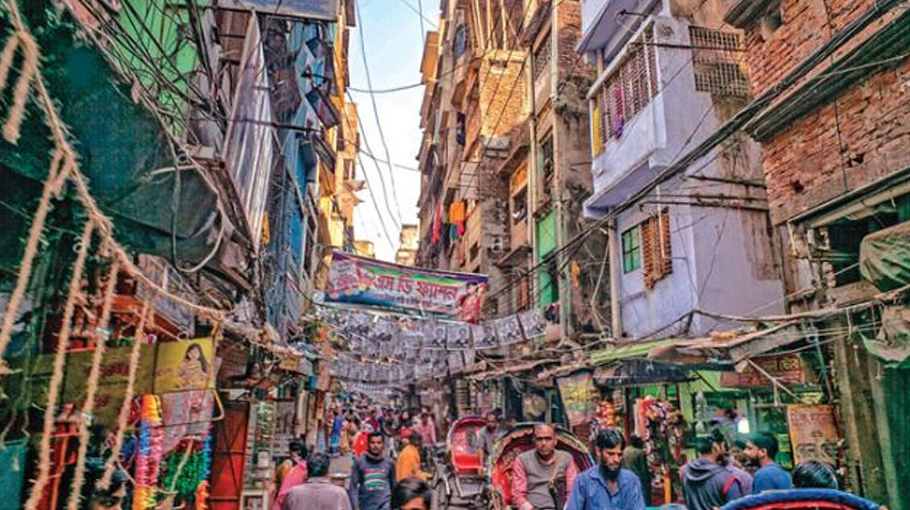Massive block-based dev plan for Old Dhaka

The government plans to specially develop and bring back the traditional architecture of old Dhaka keeping the original heritage of the ancient city unharmed.
It is known that Dhaka is at the bottom of the list of livable cities in the world and within this city, Old Dhaka is the most unplanned residential and commercial area.
RAJUK has taken the initiative to redevelop such an unplanned area on a block basis. If it is implemented, the face of the old Dhaka will change. Residents will get a modern structure of the residence.
RAJUK chairman ABM Amin Ullah Nuri told Bangladesh Post that RAJUK's DAP includes the redevelopment of old Dhaka. DAP is expected to be finalized very soon. Immediately after the gazette, initiatives will be taken to revive the heritage of old Dhaka.
He said, “Innumerable unplanned buildings crowd in lanes of old Dhaka. There is no space for air or light let alone emergency services. A block basis infrastructural development will be done. In this case, the cooperation of the people of old Dhaka will be highly important.”
To make Dhaka suitable for residence a Detailed Area Plan (DAP)-1995-2015 was undertaken. Although published in the form of DAP Gazette in June 2010, various inconsistencies were observed. Later, the government formed a 'cabinet committee' with seven ministers to review the DAP.
Later, in March 2015, RAJUK started the work of correcting the previous errors and formulating a more mature and realistic plan for DAP (2016-2035) involving the local people. At the meeting of the Cabinet Committee on DAP Review held at the Secretariat on December 30 last year, the Local Government Minister Tajul Islam confirmed that DAP was finalized. It was later sent to the Prime Minister's Office for approval and comment.
DAP Project Director Ashraful Islam told Bangladesh Post that an agreement with stakeholders in this regard is expected to be signed within the next two months. A budget for the project will be decided and a PD will be appointed at the time.
“The design for the whole project is expected to be complete within two years (by 2024). After that, the implementation will begin and hopefully, we will be able to execute it smoothly,” he said.
While talking to the correspondent, he said that the block-based projects in different parts of old Dhaka will take time according to their size and design. Some areas may take five years and some may take 10 years.
He said, “A comprehensive feasibility study consisting of physical and socio-economic survey, environmental and transport impact and social impact survey will be carried out to finalize the project area boundaries. Prior to that, project proposals need to be developed in consultation with homeowners.”
“In this case, the work of the project will be started in coordination with Dhaka South City Corporation, WASA, Titas, DESCO and all concerned government departments and people's representatives,” he added.
DAP has identified many problems in Dhaka which include dilapidated buildings, narrow roads, risky electricity connections, inadequate water supply systems, faulty drainage systems, inadequate public open spaces, high density, poor living conditions, and the risk of earthquakes and fires.
According to DAP, there are building construction rules which have not been followed in these areas of old Dhaka. Multi-storey buildings are seen leaving no room for the roads. As a result, fire service, ambulance or other emergency services have a very hard time entering these areas during mishaps. In such a situation, block-based development is necessary by uniting the small plots of old Dhaka.
However, there have been many recommendations made regarding the redevelopment of old Dhaka in DAP. These include preserving historical sites and facilities and turning them into tourism and recreation centers, creating cultural zones around the Buriganga river for old Dhaka, providing basic amenities in the area through land reclamation strategies in the process of cultural city restructuring etc.
Urban planners believe that there are many obstacles in the implementation of this project. According to experts, old Dhaka is in a very low position in the livability index. The main reasons for this are overpopulation and unplanned infrastructure.
However, redevelopment of old Dhaka is possible by ensuring civic amenities and services. Before that people need to be informed about its benefits. In addition, timely completion of projects and proportional development of property should be ensured.
Urban planner Professor Nazrul Islam told Bangladesh Post that there have been many government initiatives with Old Dhaka. However, nothing like that was implemented.
“Traffic congestion and the unorganized infrastructure is still the main problem in old Dhaka. Initiatives are needed to solve these problems. It is possible to solve this problem permanently, especially through redevelopment,” he said.
He said that before the implementation of the project, it is necessary to determine the initial financial fund and make arrangements for the initial rehabilitation of the citizens. The political commitment of the central government will also be required. Otherwise, the implementation of the project will not be successful.
Veteran architect Iqbal Habib told this correspondent that such a plan is very optimistic considering it requires the cooperation of numerous landowners and is highly dependent on their decision to comply.
“The landowners need to be offered a convincing amount of benefit in exchange for their involvement in the plan. It may seem to be unrealistic to achieve, however, if factors are considered in the plan where the landowners are assured better return, it can be possible,” he said.
“The land is a sensitive point for the people in Dhaka, especially old Dhaka. Redevelopment of such a magnitude requires consideration of many more factors that are being recommended,” he added.




